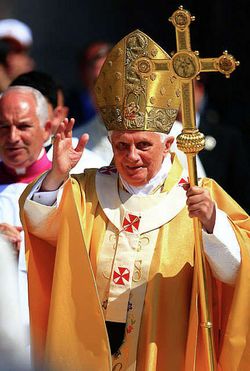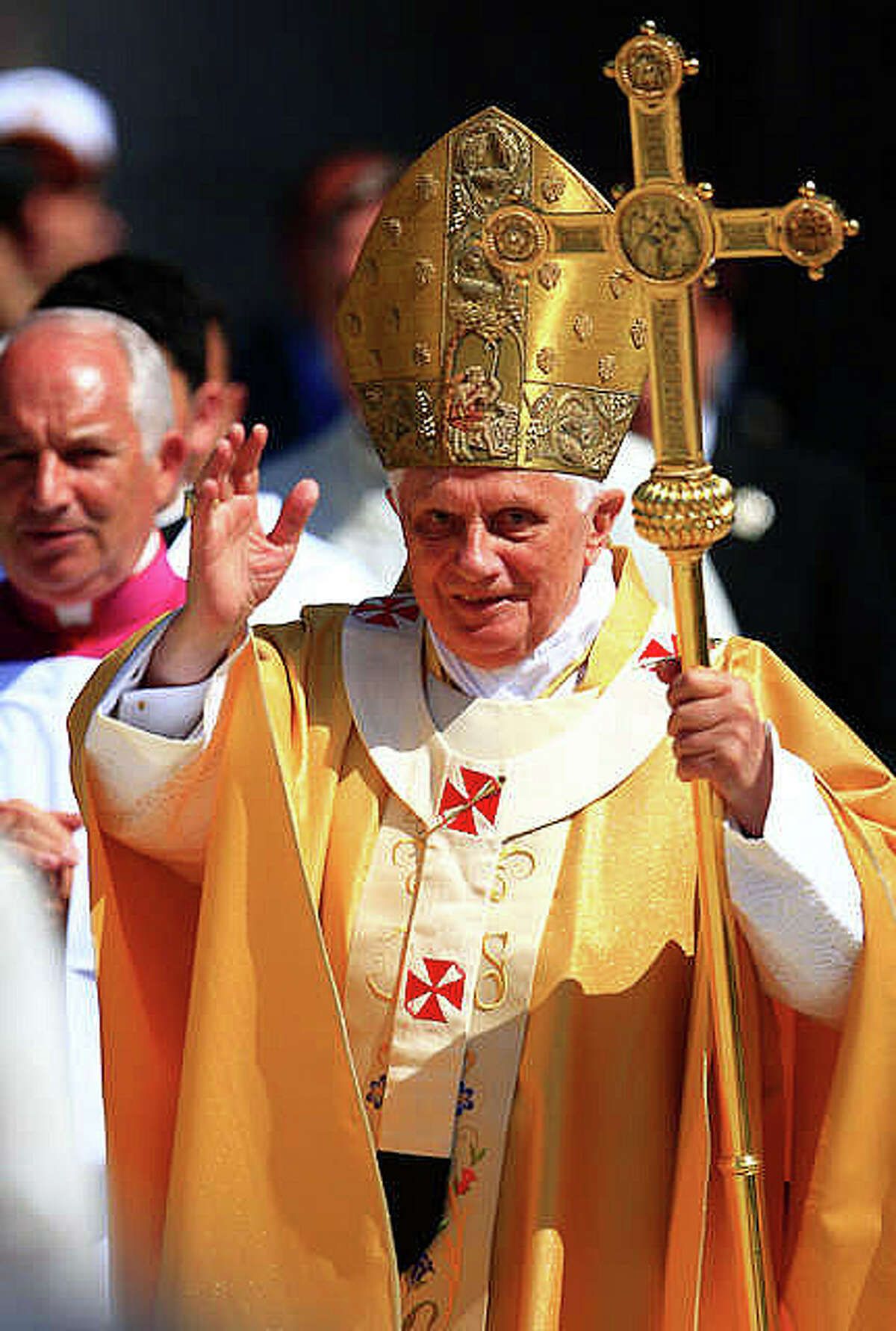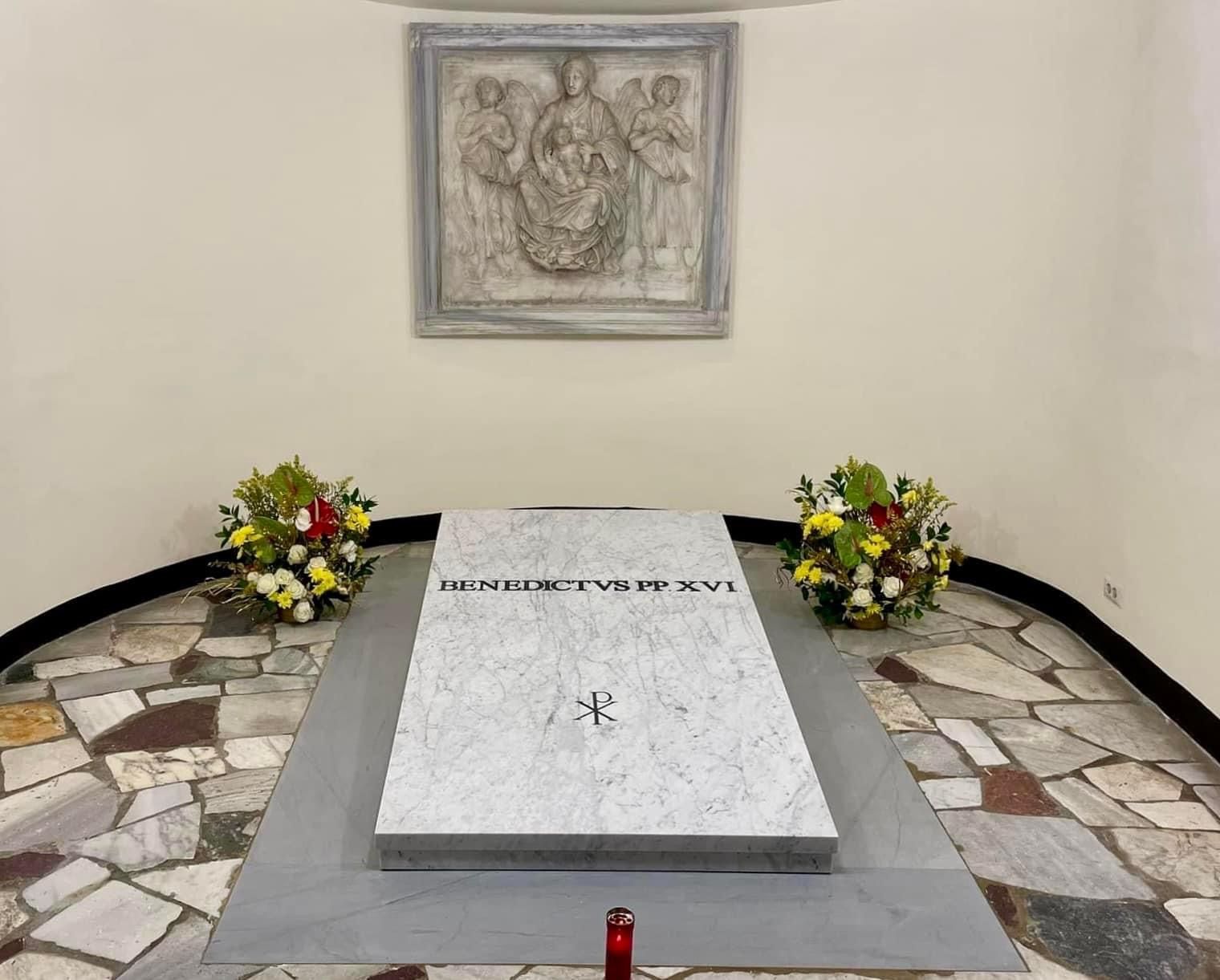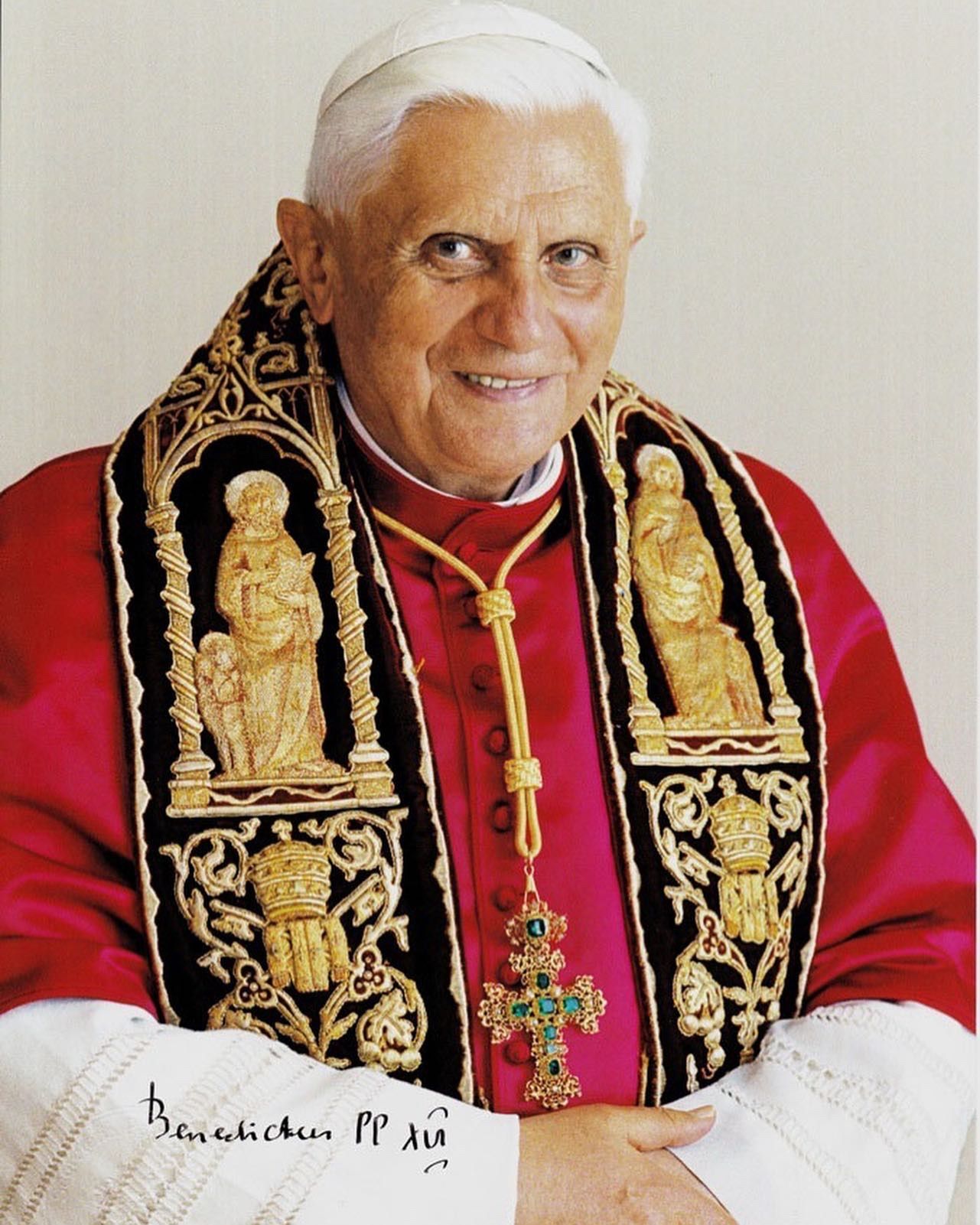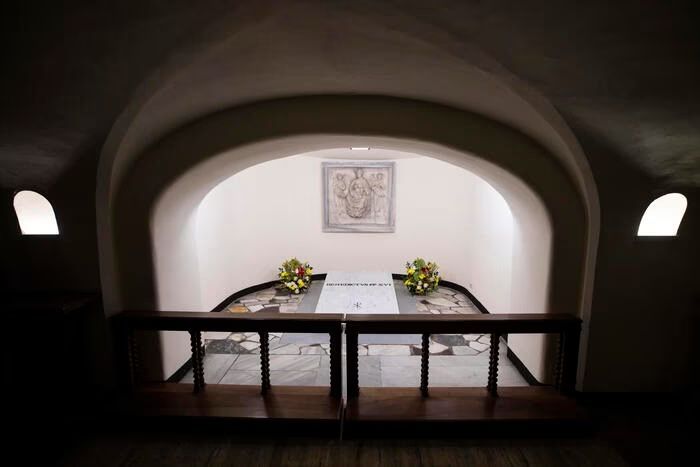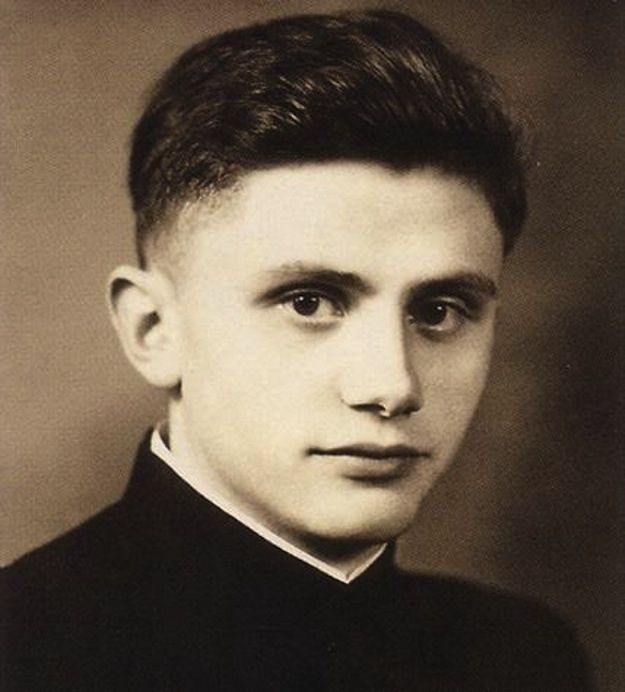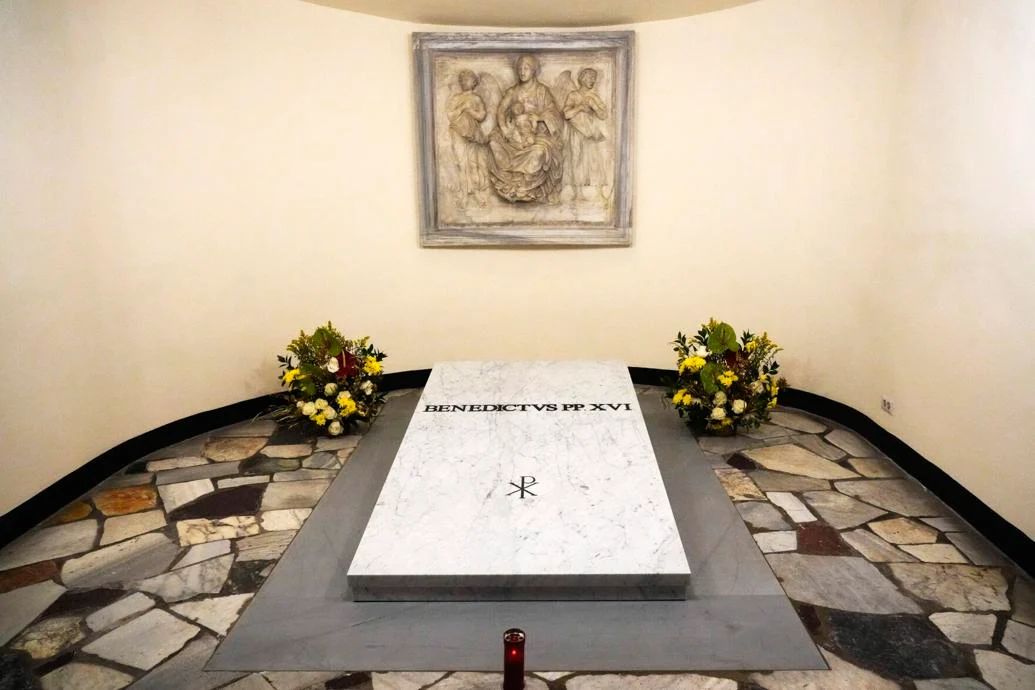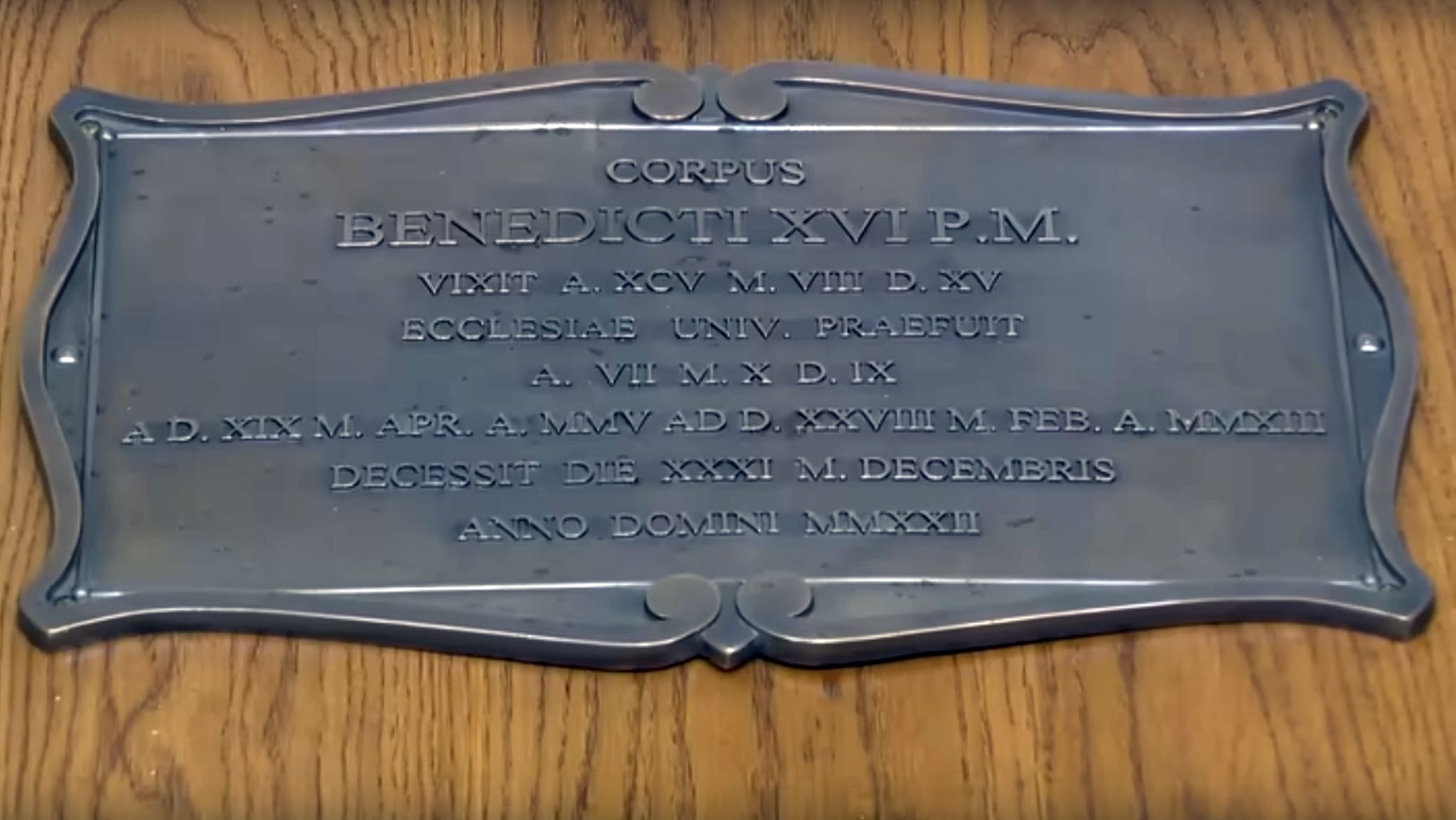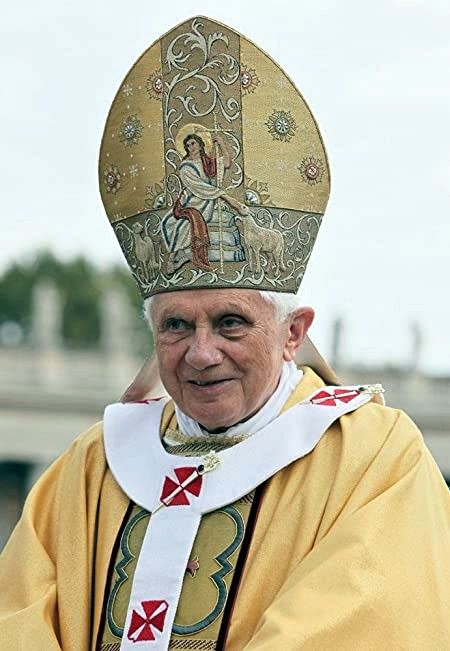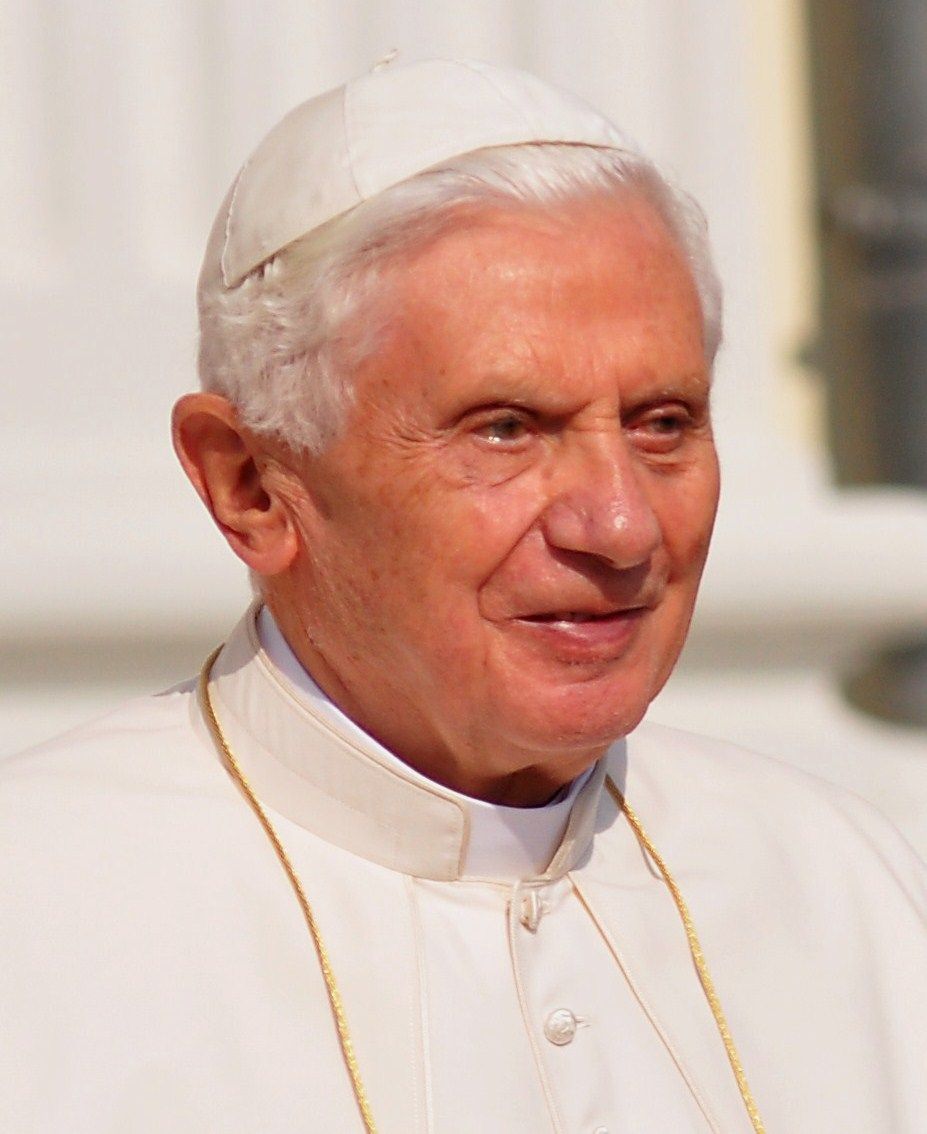Pope Benedict XVI was born and baptized Joseph Aloisius Ratzinger in Marktl in the Bavarian part of Germany on Holy Saturday, April 16, 1927, the youngest of 3 children of Joseph Ratzinger and Maria Peinter Ratzinger. His attraction to the priesthood was noted from age 5. At age 7, he wrote a Christmas letter to the Child Jesus asking for his own missal for Mass and a green vestment so that he and his brother could play at being priests. At age 10, he enrolled in a school that taught classical languages and began translating the Greek Gospels into German. Around age 14, he translated liturgical texts from Latin into German.
Common for young German men of his generation, he was forcefully drafted into the Hitler Youth program, experiencing firsthand Nazi indoctrination, but soon stopped going to meetings. When he was 14 years old, he had seen his cousin, who was born with Down Syndrome, taken from his home by Nazi officials. The family never saw the child again, later learning he had died, likely murdered. Such experiences informed his teaching and doctrine. As Pope, he often stressed the Church's objections to euthanasia, calling it a "false solution" to human suffering.
At age 16, he was forced into military service. He was tasked with making target calculations to protect a BMW plant from air raids. From there, he was moved to other posts, but never as an infantryman, unlike his brother, Georg, who was injured in battle. When the SS intimidated young men to volunteer for their unit, he openly confessed that he wanted to become a Catholic priest. He accepted ridicule because it kept him from being conscripted.
A couple of weeks after his 18th birthday, Hitler's death was reported. Shortly thereafter, in the spring of 1945, he made a decision to abandon his post. Despite being spotted by 2 guards, he was allowed to continue unharmed and made his way home. The danger continued. Two SS soldiers forcibly took residence in the Ratzinger home. They began to make inquiries about his status. Soldiers who had left their units had already been hanged, but the 2 disappeared the next day.
After the war, late in 1945, he and his brother entered the seminary together. The future Bishop of Rome was ordained to the priesthood with his brother on June 29, 1951, the Feast of Sts. Peter and Paul, the 2 great apostles of Rome.
After 14 months of parish ministry, he was sent back to finish his doctorate in theology. In 1953, he earned a doctorate in theology after successfully defending his thesis, "The People and House of God in St. Augustine's Doctrine of the Church." Four years later, he qualified as a university professor with a dissertation on the theology of the history of St. Bonaventure.
He went on to teach Dogmatics and History of Dogma at the Higher School of Philosophy and Theology of Freising from 1952 to 1959, the University of Bonn from 1959 to 1963, the University of Münster from 1963 to 1969, the University of Tübingen from 1966 to 1969, and the University of Ratisbon from 1969 to 1977.
From 1962 to 1965, he served as a theological consultant to Joseph Cardinal Frings, Archbishop of Cologne, during the Second Vatican Council and was considered one of the brightest minds of the council. Though he initially subscribed to a more liberal perspective, by the late 1960s, his ideas were beginning to be recognized as among the more orthodox in the Church.
In 1969, he was appointed Vice President and Professor of Dogmatic Theology at the University of Regensburg where, decades later, he would deliver his famous Regensburg address that denounced relativism.
Pope Paul VI appointed him Archbishop of Munich and Freising on March 24, 1977. He chose "Collaborator of the Truth," as his episcopal motto, highlighting the union between Faith and Reason, which would remain central to his teaching. Pope Paul VI elevated him to Cardinal on June 27 in a consistory in St. Peter's Basilica.
In 1981, at age 54, Pope John Paul II called him to Rome to head the Vatican's Congregation for the Doctrine of the Faith (CDF), where he served for 24 years until his papal election in 2005. During his time as prefect of the CDF, he rose through the Roman Curia, being appointed Vice-Dean of the College of Cardinals in 1998 and Dean in 2002. In 1981, he was also appointed President of the Pontifical Biblical Commission and the International Theological Commission.
As Prefect of the Congregation of the Doctrine of the Faith, he defended and reaffirmed official Catholic teaching on birth control, homosexuality, and interreligious dialogue. He also upheld the teaching against the ordination of women and stated that it belonged to the Deposit of Faith, meaning that it was beyond the jurisdiction of any pope to change.
His sometimes fierce defense of the Faith earned him the appellation of "God's Rottweiler," although he was also described as gentle, pious, and even "sweet-tempered."
In 1984, he issued a 36-page essay that critiqued leftist politicization of doctrine in Latin America and elsewhere. Two years later, he issued a second instruction that expanded his discussion regarding Marxist infiltration into the Church. During this period, the CDF took disciplinary measures against a number of radical liberation theologians in Latin America and chastised the work of other leftist religious activists throughout the world.
From 1986 to 1992 he served as President of the Commission for Drafting the Catechism of the Catholic Church.
During his tenure as Prefect, the 1999 Joint Declaration on the Doctrine of Justification was signed with the Lutheran World Federation, which he oversaw. The ecumenical Declaration called for continued dialogue in order to reach full church communion. He was a strong supporter of Vatican II's document on the Church's relation with non-Christian religions
Following the death of Pope John Paul II on April 2, 2005, he offered the funeral Mass for the late pontiff on April 8, 2005, in his capacity as Dean of the College of Cardinals.
He was elected Pope on April 19, 2005, at age 78, on the 4th ballot by 115 votes, the highest number in conclave history, on the second day of the conclave which lasted under 24 hours. He explained that he took the name Benedict to evoke the memory of Pope Benedict XV, a "courageous prophet of peace" during World War I, and also in memory of St. Benedict, patriarch of western monasticism and co-patron saint of Europe, referring to the Christian roots of Europe.
His papacy was extremely busy for a man who already had a pacemaker and who had wanted to retire to study, write, and pray when he turned 75. He was a classically-trained pianist who would practice often, even as Pope.
Less than one month after his election, on May 13, 2005, he waived the customary 5-year waiting period outlined in Canon Law and announced the beginning of the beatification process for his predecessor Pope John Paul II. On May 1, 2011, he presided over the beatification of Pope John Paul II in St. Peter's Square. He canonised over 40 saints during his pontificate.
In 2006, he spoke in the Great Hall of the University of Regensburg, where he had once served as professor, and delivered a lecture entitled "Faith, Reason, and the University: Memories and Reflections."
He spoke to world youth each year of his papacy. In 2009, he spoke to them with words of comfort and, at the same time, words of warning about the reality of being a Christian in the 21st century. He presided 3 times over World Youth Day mega-gatherings: in Germany in 2005, Australia in 2008, and Spain in 2011.
Also in 2009, he issued his apostolic constitution Anglicanorum Coetibus which allowed for personal ordinariates for Anglicans to enter into the Catholic Church. The document established norms for members of both the Anglican laity and clergy to convert and then live as Catholics. It resulted in an influx of converts to the Catholic Church, with personal ordinariates being established in England, the United States, and Australia. By 2019, members of the 3 ordinariates numbered in excess of 9,000, with nearly 200 priests and 94 parishes.
During the 8 years of his papacy, he issued 3 encyclicals treating the theological virtues of faith, hope, and charity, in light of current theological and social problems.
Unique in their references both to secular authors like Plato, Cicero, Nietzsche, Marx, and Dostoevsky, as well as to Fathers and Doctors of the Church, the encyclicals revealed the breadth of his scholarship.
In Caritas in Veritate (Charity in Truth), he tackled many modern social issues including international trade and finance as well as abortion, sterilization, and euthanasia in light of Catholic teaching.
He began his first papal visit to Latin America by endorsing the excommunication of pro-abortion politicians. He identified the right to life as a "non-negotiable" value, often alongside the protection of marriage and parental and conscience rights. He declared pro-abortion legislation "incompatible with participation in the Eucharist." He repeatedly stressed, "The fundamental human right, the presupposition of every other right, is the right to life itself."
Among his writings, the 2007 motu proprio Summorum Pontificum stands out in anchoring the Tridentine Mass on firm liturgical footing. He made the case that the traditional Latin Mass, which he called the "Extraordinary Form," could no longer be left behind as a thing of the past. He told the world's bishops in a letter that accompanied the motu proprio, "What earlier generations held as sacred, remains sacred and great for us too, and it cannot be all of a sudden entirely forbidden or even considered harmful."
At the time of its issuance, Vatican Cardinal Darío Castrillón Hoyos explained the significance of this document in light of Vatican II. "The Holy Father, who is a theologian involved in the preparation for the council, is taking a treasure from the past to offer it alongside the rich celebration of the new rite."
In a personal search for God, Benedict published, in 2007, Jesus of Nazareth: From the Baptism in the Jordan to the Transfiguration, a 3-volume book on the life and teachings of Jesus Christ.
He explicitly condemned the sexual abuse committed by clergy and the way in which the problem had been handled by the bishops in an attempt to avoid scandal. He was the first Pope to meet with the victims of sexual abuse.
During his near 8 years as Pope, he wrote 3 encyclicals, 13 motu proprios, 68 Apostolic Letters, and 4 apostolic exhortations. He created 90 cardinals in 5 consistories, and made 25 official trips outside of Italy to 6 continents.
He shocked the world by announcing his resignation on February 11, 2013. He had 3 times tried to resign from his position as Prefect under Pope John Paul II, but was refused. He had long hoped to write books and to prepare prayerfully for death. He was the first pope in 598 years to retire. He delivered the message of his retirement in Latin during a meeting of Vatican cardinals.
"After having repeatedly examined my conscience before God, I have come to the certainty that my strengths due to an advanced age are no longer suited to an adequate exercise of the Petrine ministry," he told the cardinals. "Strengths which in the last few months have deteriorated in me to the extent that I have had to recognize my incapacity to adequately fulfill the ministry entrusted to me."
Following his announcement on February 11, 2013, he resigned on February 28, staying briefly at Castel Gandolfo, before moving to his more permanent home of the Mater Ecclesiae Monastery in the Vatican Gardens on May 2, 2013. His reign as Pope was just under 8 years. He took the title "Pope Emeritus" and continued wearing a white cassock.
By the time he had been retired for a year, his daily routine was set. His days began with Mass, morning prayer, and breakfast. He continued welcoming old friends and colleagues, engaging in dialogue or offering spiritual counsel. He spent hours reading and dealing with correspondence before a 4 p.m. stroll in the garden and recitation of the rosary.
On his only post-retirement trip outside of Italy, he flew to his native Bavaria in June 2020 for a 5-day visit with his ailing 96-year-old brother, Georg Ratzinger, who died a few days after the visit. He took ill shortly after the visit, never recovering his full strength.
Pope Emeritus Benedict XVI, passed away on December 31, 2022, at 9:34 a.m. in the Mater Ecclesiae Monastery in the Vatican, 17 years after he ascended to the papal throne, 45 years after he was consecrated bishop in 1977, and 71 years after he was ordained a priest in 1951. He was the longest-living pope in history at age 95. His final words were "Lord, I love you."
From January 2 to January 4, 2023, his body was in St. Peter's Basilica for the world to bid farewell. The funeral was celebrated at 9:30 a.m, January 5, in St. Peter's Square. He was interred in the tomb vacated by Pope John Paul II, as he wished.
Pope Benedict XVI was born and baptized Joseph Aloisius Ratzinger in Marktl in the Bavarian part of Germany on Holy Saturday, April 16, 1927, the youngest of 3 children of Joseph Ratzinger and Maria Peinter Ratzinger. His attraction to the priesthood was noted from age 5. At age 7, he wrote a Christmas letter to the Child Jesus asking for his own missal for Mass and a green vestment so that he and his brother could play at being priests. At age 10, he enrolled in a school that taught classical languages and began translating the Greek Gospels into German. Around age 14, he translated liturgical texts from Latin into German.
Common for young German men of his generation, he was forcefully drafted into the Hitler Youth program, experiencing firsthand Nazi indoctrination, but soon stopped going to meetings. When he was 14 years old, he had seen his cousin, who was born with Down Syndrome, taken from his home by Nazi officials. The family never saw the child again, later learning he had died, likely murdered. Such experiences informed his teaching and doctrine. As Pope, he often stressed the Church's objections to euthanasia, calling it a "false solution" to human suffering.
At age 16, he was forced into military service. He was tasked with making target calculations to protect a BMW plant from air raids. From there, he was moved to other posts, but never as an infantryman, unlike his brother, Georg, who was injured in battle. When the SS intimidated young men to volunteer for their unit, he openly confessed that he wanted to become a Catholic priest. He accepted ridicule because it kept him from being conscripted.
A couple of weeks after his 18th birthday, Hitler's death was reported. Shortly thereafter, in the spring of 1945, he made a decision to abandon his post. Despite being spotted by 2 guards, he was allowed to continue unharmed and made his way home. The danger continued. Two SS soldiers forcibly took residence in the Ratzinger home. They began to make inquiries about his status. Soldiers who had left their units had already been hanged, but the 2 disappeared the next day.
After the war, late in 1945, he and his brother entered the seminary together. The future Bishop of Rome was ordained to the priesthood with his brother on June 29, 1951, the Feast of Sts. Peter and Paul, the 2 great apostles of Rome.
After 14 months of parish ministry, he was sent back to finish his doctorate in theology. In 1953, he earned a doctorate in theology after successfully defending his thesis, "The People and House of God in St. Augustine's Doctrine of the Church." Four years later, he qualified as a university professor with a dissertation on the theology of the history of St. Bonaventure.
He went on to teach Dogmatics and History of Dogma at the Higher School of Philosophy and Theology of Freising from 1952 to 1959, the University of Bonn from 1959 to 1963, the University of Münster from 1963 to 1969, the University of Tübingen from 1966 to 1969, and the University of Ratisbon from 1969 to 1977.
From 1962 to 1965, he served as a theological consultant to Joseph Cardinal Frings, Archbishop of Cologne, during the Second Vatican Council and was considered one of the brightest minds of the council. Though he initially subscribed to a more liberal perspective, by the late 1960s, his ideas were beginning to be recognized as among the more orthodox in the Church.
In 1969, he was appointed Vice President and Professor of Dogmatic Theology at the University of Regensburg where, decades later, he would deliver his famous Regensburg address that denounced relativism.
Pope Paul VI appointed him Archbishop of Munich and Freising on March 24, 1977. He chose "Collaborator of the Truth," as his episcopal motto, highlighting the union between Faith and Reason, which would remain central to his teaching. Pope Paul VI elevated him to Cardinal on June 27 in a consistory in St. Peter's Basilica.
In 1981, at age 54, Pope John Paul II called him to Rome to head the Vatican's Congregation for the Doctrine of the Faith (CDF), where he served for 24 years until his papal election in 2005. During his time as prefect of the CDF, he rose through the Roman Curia, being appointed Vice-Dean of the College of Cardinals in 1998 and Dean in 2002. In 1981, he was also appointed President of the Pontifical Biblical Commission and the International Theological Commission.
As Prefect of the Congregation of the Doctrine of the Faith, he defended and reaffirmed official Catholic teaching on birth control, homosexuality, and interreligious dialogue. He also upheld the teaching against the ordination of women and stated that it belonged to the Deposit of Faith, meaning that it was beyond the jurisdiction of any pope to change.
His sometimes fierce defense of the Faith earned him the appellation of "God's Rottweiler," although he was also described as gentle, pious, and even "sweet-tempered."
In 1984, he issued a 36-page essay that critiqued leftist politicization of doctrine in Latin America and elsewhere. Two years later, he issued a second instruction that expanded his discussion regarding Marxist infiltration into the Church. During this period, the CDF took disciplinary measures against a number of radical liberation theologians in Latin America and chastised the work of other leftist religious activists throughout the world.
From 1986 to 1992 he served as President of the Commission for Drafting the Catechism of the Catholic Church.
During his tenure as Prefect, the 1999 Joint Declaration on the Doctrine of Justification was signed with the Lutheran World Federation, which he oversaw. The ecumenical Declaration called for continued dialogue in order to reach full church communion. He was a strong supporter of Vatican II's document on the Church's relation with non-Christian religions
Following the death of Pope John Paul II on April 2, 2005, he offered the funeral Mass for the late pontiff on April 8, 2005, in his capacity as Dean of the College of Cardinals.
He was elected Pope on April 19, 2005, at age 78, on the 4th ballot by 115 votes, the highest number in conclave history, on the second day of the conclave which lasted under 24 hours. He explained that he took the name Benedict to evoke the memory of Pope Benedict XV, a "courageous prophet of peace" during World War I, and also in memory of St. Benedict, patriarch of western monasticism and co-patron saint of Europe, referring to the Christian roots of Europe.
His papacy was extremely busy for a man who already had a pacemaker and who had wanted to retire to study, write, and pray when he turned 75. He was a classically-trained pianist who would practice often, even as Pope.
Less than one month after his election, on May 13, 2005, he waived the customary 5-year waiting period outlined in Canon Law and announced the beginning of the beatification process for his predecessor Pope John Paul II. On May 1, 2011, he presided over the beatification of Pope John Paul II in St. Peter's Square. He canonised over 40 saints during his pontificate.
In 2006, he spoke in the Great Hall of the University of Regensburg, where he had once served as professor, and delivered a lecture entitled "Faith, Reason, and the University: Memories and Reflections."
He spoke to world youth each year of his papacy. In 2009, he spoke to them with words of comfort and, at the same time, words of warning about the reality of being a Christian in the 21st century. He presided 3 times over World Youth Day mega-gatherings: in Germany in 2005, Australia in 2008, and Spain in 2011.
Also in 2009, he issued his apostolic constitution Anglicanorum Coetibus which allowed for personal ordinariates for Anglicans to enter into the Catholic Church. The document established norms for members of both the Anglican laity and clergy to convert and then live as Catholics. It resulted in an influx of converts to the Catholic Church, with personal ordinariates being established in England, the United States, and Australia. By 2019, members of the 3 ordinariates numbered in excess of 9,000, with nearly 200 priests and 94 parishes.
During the 8 years of his papacy, he issued 3 encyclicals treating the theological virtues of faith, hope, and charity, in light of current theological and social problems.
Unique in their references both to secular authors like Plato, Cicero, Nietzsche, Marx, and Dostoevsky, as well as to Fathers and Doctors of the Church, the encyclicals revealed the breadth of his scholarship.
In Caritas in Veritate (Charity in Truth), he tackled many modern social issues including international trade and finance as well as abortion, sterilization, and euthanasia in light of Catholic teaching.
He began his first papal visit to Latin America by endorsing the excommunication of pro-abortion politicians. He identified the right to life as a "non-negotiable" value, often alongside the protection of marriage and parental and conscience rights. He declared pro-abortion legislation "incompatible with participation in the Eucharist." He repeatedly stressed, "The fundamental human right, the presupposition of every other right, is the right to life itself."
Among his writings, the 2007 motu proprio Summorum Pontificum stands out in anchoring the Tridentine Mass on firm liturgical footing. He made the case that the traditional Latin Mass, which he called the "Extraordinary Form," could no longer be left behind as a thing of the past. He told the world's bishops in a letter that accompanied the motu proprio, "What earlier generations held as sacred, remains sacred and great for us too, and it cannot be all of a sudden entirely forbidden or even considered harmful."
At the time of its issuance, Vatican Cardinal Darío Castrillón Hoyos explained the significance of this document in light of Vatican II. "The Holy Father, who is a theologian involved in the preparation for the council, is taking a treasure from the past to offer it alongside the rich celebration of the new rite."
In a personal search for God, Benedict published, in 2007, Jesus of Nazareth: From the Baptism in the Jordan to the Transfiguration, a 3-volume book on the life and teachings of Jesus Christ.
He explicitly condemned the sexual abuse committed by clergy and the way in which the problem had been handled by the bishops in an attempt to avoid scandal. He was the first Pope to meet with the victims of sexual abuse.
During his near 8 years as Pope, he wrote 3 encyclicals, 13 motu proprios, 68 Apostolic Letters, and 4 apostolic exhortations. He created 90 cardinals in 5 consistories, and made 25 official trips outside of Italy to 6 continents.
He shocked the world by announcing his resignation on February 11, 2013. He had 3 times tried to resign from his position as Prefect under Pope John Paul II, but was refused. He had long hoped to write books and to prepare prayerfully for death. He was the first pope in 598 years to retire. He delivered the message of his retirement in Latin during a meeting of Vatican cardinals.
"After having repeatedly examined my conscience before God, I have come to the certainty that my strengths due to an advanced age are no longer suited to an adequate exercise of the Petrine ministry," he told the cardinals. "Strengths which in the last few months have deteriorated in me to the extent that I have had to recognize my incapacity to adequately fulfill the ministry entrusted to me."
Following his announcement on February 11, 2013, he resigned on February 28, staying briefly at Castel Gandolfo, before moving to his more permanent home of the Mater Ecclesiae Monastery in the Vatican Gardens on May 2, 2013. His reign as Pope was just under 8 years. He took the title "Pope Emeritus" and continued wearing a white cassock.
By the time he had been retired for a year, his daily routine was set. His days began with Mass, morning prayer, and breakfast. He continued welcoming old friends and colleagues, engaging in dialogue or offering spiritual counsel. He spent hours reading and dealing with correspondence before a 4 p.m. stroll in the garden and recitation of the rosary.
On his only post-retirement trip outside of Italy, he flew to his native Bavaria in June 2020 for a 5-day visit with his ailing 96-year-old brother, Georg Ratzinger, who died a few days after the visit. He took ill shortly after the visit, never recovering his full strength.
Pope Emeritus Benedict XVI, passed away on December 31, 2022, at 9:34 a.m. in the Mater Ecclesiae Monastery in the Vatican, 17 years after he ascended to the papal throne, 45 years after he was consecrated bishop in 1977, and 71 years after he was ordained a priest in 1951. He was the longest-living pope in history at age 95. His final words were "Lord, I love you."
From January 2 to January 4, 2023, his body was in St. Peter's Basilica for the world to bid farewell. The funeral was celebrated at 9:30 a.m, January 5, in St. Peter's Square. He was interred in the tomb vacated by Pope John Paul II, as he wished.
Bio by: Angela
Gravesite Details
The cypress coffin in which Benedict XVI rests in the crypt contains coins and medals minted during his pontificate, his pallium (liturgical garment) as well as a text briefly describing his pontificate, placed in a metal cylinder.
Family Members
Advertisement
See more Benedict XVI memorials in:
Advertisement
